UPDATE (03.05.2022): Post lightly edited for clarity.
Welcome back to my ongoing NYTIP series! In my last post, I began expounding on point two in my three-point plan to fix the NYC Subway – extend – with SAS Phase 2X and an Astoria line extension to LaGuardia Airport. In this post, I will discuss the Concourse line extension to Co-op City and accompanying improvements.
Note: Click any image to enlarge.
Let us begin with a brief history of the Grand Boulevard and Concourse line. The Concourse line opened in 1933. However, plans for its extension date back to 1929:
[Fig. 1] Snippet of the ambitious 1929 IND Second System plan showing the Concourse line extension.
From Norwood – 205th Street station, the proposed extension would’ve emerged briefly to cross over the Bronx River before returning underground at Burke Avenue. (The proposal also included a westward extension of Burke Avenue to Webster Avenue.) From Burke Avenue, the line would’ve continued along Boston Road to Baychester Avenue. The Great Depression of 1929 killed both this plan and the Concourse line’s original four-track layout. Instead, the city built a three-track line to Bedford Park with two tracks continuing to Norwood and a provision for an eastward extension. After the New York, Westchester, and Boston (NYW&B) railway ceased service in 1937, the city planned a modified Concourse line extension via Burke Avenue and the NYW&B right-of-way to Eastchester – Dyre Avenue. However, to save costs, the city connected the NYW&B to the IRT White Plains Road line instead, forming today’s 5 train.
In 1968, the MTA planned a short Concourse line extension to White Plains Road, connecting with the IRT White Plains Road line at either Burke Avenue or Gun Hill Road station. However, this plan never came to fruition either. The MTA has not proposed any Concourse line extensions since then.
What would be the rationale for a Concourse line extension today? There are several justifications for it, including:
- Co-op City. Co-op City is the largest housing cooperative on Earth. It has several shopping plazas – including the ever-busy Bay Plaza mall – and it’s one of the largest neighborhoods in NYC unserved by rapid transit. (Eventually, MTA’s Penn Station Access (PSA) project will serve Co-op City – but not until at least 2027.)
- Cross-Bronx transit. The Bronx has very little crosstown rapid transit coverage compared to other boroughs served by the NYC Subway. The busiest bus route in The Bronx – and one of the busiest in NYC – is a crosstown route, the Bx12.
- Relieving traffic congestion. All of The Bronx’s crosstown buses perform poorly due to chronic delays and car-caused traffic congestion; most of The Bronx’s crosstown routes received grades of D or F from the Bus Turnaround Coalition. Co-op City and surrounding areas also suffer traffic woes due to their proximity to I-95 and the Hutch.
With PSA eventually coming to Co-op City, an opportunity exists to create a major transit hub. Several buses already serve Co-op City; the missing link, therefore, is the subway. Thus, extending subway service to Co-op City is a key element of NYTIP, and the Concourse and Pelham lines (respectively, the D and 6 trains) are best suited for this purpose. Let us now explore several extension options.
Option 1: Extension to Co-op City via Burke Avenue
[Figs. 2, 3] Overview of Option 1. Created using Brand New Subway.
Option 1 is a modified version of the 1929 Concourse line extension plan. Option 1 would begin the same way as the 1929 plan with an extension to Burke Avenue. Rather than turn northward onto Boston Road, however, the line would traverse Gun Hill Road instead. Due to a steep decline east of Eastchester Road, the line would emerge onto an el in this area. Option 1a establishes a transit hub at Co-op City South, while Option 1b establishes a hub at Bartow Mall. The extension includes connections to the 2 and 5 lines, several bus routes, and the future PSA station.
A major complication with this option is that it is most likely infeasible. The Bronx Park Preserve, bounded approximately by Gun Hill Road to the north, the Metro-North tracks to the west, Allerton Avenue to the south, and the Bronx River Parkway to the east, is a Forever Wild site. Per New York State Constitution Article XIV, such land can’t be developed for any reason except as provided in said article. Therefore, unless the Burke Avenue extension doesn’t run afoul of Forever Wild rules, the Concourse line extension must traverse an alternate route that does not disturb the Bronx Park Preserve. This leads us to:
Option 2: Extension to Co-op City via Gun Hill Road
[Figs. 4, 5] Overview of Option 2.
Option 2 sends the D train to new stations at Williamsbridge Plaza (2 train), Boston Road, and Eastchester Road (5 train). As with Option 1, Option 2a creates a hub at Co-op City South, while Option 2b creates a hub at Bartow Mall.
While the Gun Hill Road alignment may seem like a long detour compared to the Burke Avenue alignment, the approximate difference in distance between the two is actually less than 1/3 mile. At an average speed of 20 MPH, this amounts to less than one minute of additional travel time in each direction. Furthermore, the Gun Hill Road alignment offers the same connections to existing subways as the Burke Avenue alignment.
Some time ago, vanshnookenraggen chimed in with an idea of his own – namely, extending the Concourse line such that it serves the Montefiore/North Central hospital complex directly (possibly sacrificing the Norwood – 205th Street station). Vansh’s idea is similar to Option 2 and has merit, given that the Montefiore/North Central hospital complex is a major employer of Bronxites. However, I wouldn’t dispense with the Norwood – 205th Street station. Allow me, therefore, to present a modified version of Vansh’s idea.
Option 3: Extension to Co-op City via 210th Street and Gun Hill Road
[Figs. 6, 7] Overview of Option 3.
As with Options 1 and 2, Option 3a provides a hub at Co-op City South, while Option 3b provides a hub at Bartow Mall. Rather than eliminate the Norwood – 205th Street station, Option 3 extends the C train to said station to avoid bottlenecks at the single-track Bedford Park Boulevard terminal. There appears to be enough room to build new ramps for D trains immediately north of Bedford Park Boulevard station, which would result in the following track configuration:
[Fig. 8] Option 3 track map. (Original track map by vanshnookenraggen.)
The ramps are but one challenge with Option 3. Ground elevation is another:
[Fig. 9] Option 3b elevation profile.
At 210th Street, the ground rises about 37 feet relative to Bedford Park Boulevard before dropping significantly; from Bainbridge Avenue to Webster Avenue, the change in elevation is about 116 feet at an average grade of 5.5%. The end result is either a deep station at Norwood – 210th Street (about 100 feet or so below street level) to allow the subway to cross under the Bronx River, or a shallower station that allows for an el portal west of the Bronx River. The only place I can see such a portal is on Gun Hill Road itself between Hull and Webster Avenues; this requires bisecting Decatur Avenue and narrowing Gun Hill Road to a single travel lane in each direction. (Gun Hill Road could use traffic calming treatments, but that’s another conversation.)
As of 12.23.2021, I am leaning on Option 3b. Option 3b creates a transit hub at the center of Co-op City at Bartow Mall and Bay Plaza, relieves traffic on Gun Hill Road by providing a rapid transit alternative, and provides direct subway service to the Montefiore/North Central hospital complex.
Optional Enhancement 1: Westchester Square Express Stop Conversion
The 6 extension to Co-op City has high ridership potential, owing both to Co-op City’s size and the Bay Plaza mall. Consequently, it could exacerbate crowding conditions on the 6. To mitigate this, the 6 extension includes an optional capital investment – converting Westchester Square – East Tremont Avenue station to an express stop:
[Fig. 10] Optional Westchester Square express stop conversion.
This conversion promotes faster peak-directional express service and expanded local service on the 6 line in The Bronx. As a terminal for local trains, it offers an important advantage over Parkchester – local and express trains no longer cross in front of each other. Terminating local trains use the Westchester Yard leads to change directions, while express trains continue northward to Co-op City with minimal conflict. As of 12.23.2021, the 6 extension would include this conversion.
Optional Enhancement 2: Co-op City Jughandle
[Fig. 11] Overview of the Co-op City Jughandle.
The purpose of the Co-op City Jughandle is to provide direct subway service to the north side of Co-op City. It modifies the Dyre Avenue line to provide a new station at Co-op City’s Peartree Square; the modification requires several curves – one of which also necessitates relocating Baychester Avenue station about 300-400 feet southward.
As of 12.23.2021, NYTIP would not include the Co-op City Jughandle.
Optional Enhancement 3: Concourse Line Fourth Track
The Concourse line has three tracks, but was originally designed for four. Evidence for a fourth track provision exists in two places – at the extra-wide northbound platform at 145th Street station’s lower level and the existing four-track segment between 170th Street and 167th Street stations. Consequently, these would be the staging areas for a fourth track installation. The following figures show what a four-track Concourse line could look like:
[Figs. 12, 13, 14, 15] Overview of the four-track Concourse line.
While modifying track maps is easy, the Concourse line fourth track installation is anything but. It requires constructing a new ramp from the Central Park West line to the lower level at 145th Street, demolishing and rebuilding all southbound platforms with ADA treatments from 155th Street to Bedford Park Boulevard, ADA treatments at all northbound platforms, a new underwater tunnel, a new crossover tunnel between Kingsbridge Road and Bedford Park Boulevard, and track realignments at Fordham Road and Bedford Park Boulevard.
In short, it would be an expensive undertaking. Benefits include expanded express service and an eliminated merge between C and D trains, which would further improve Concourse line service. While such an improvement is near and dear to me, it is realistically a “nice to have”. Therefore, as of 12.23.2021, NYTIP would not include the Concourse line fourth track, for now. The Co-op City extension must take priority. Given relatively balanced ridership between local and express stops on the Concourse line, expanding peak-directional express service to weekends would provide speed improvements in lieu of a fourth track – at least in the near term. However, I won’t write off the fourth track entirely – I might include it in the expansion phase of NYTIP.

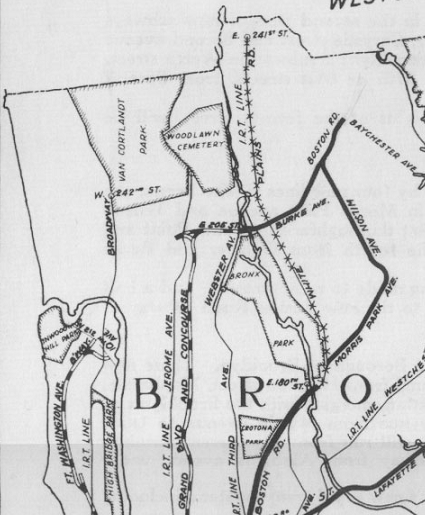
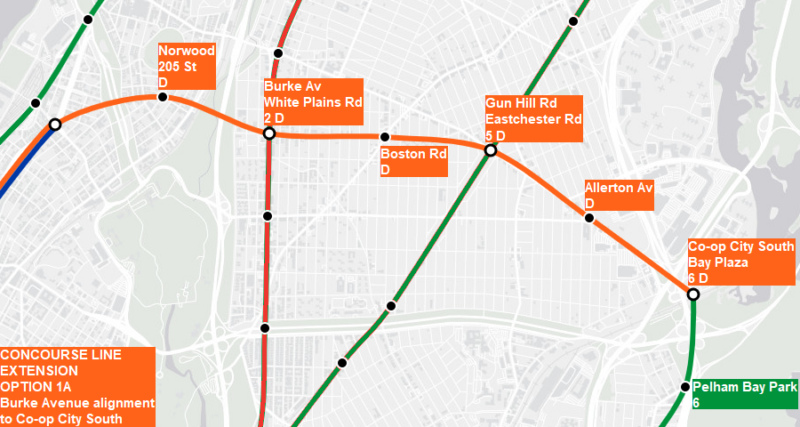
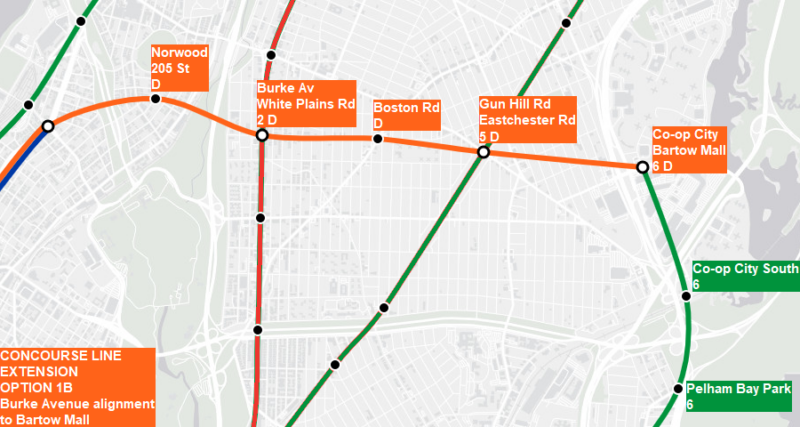
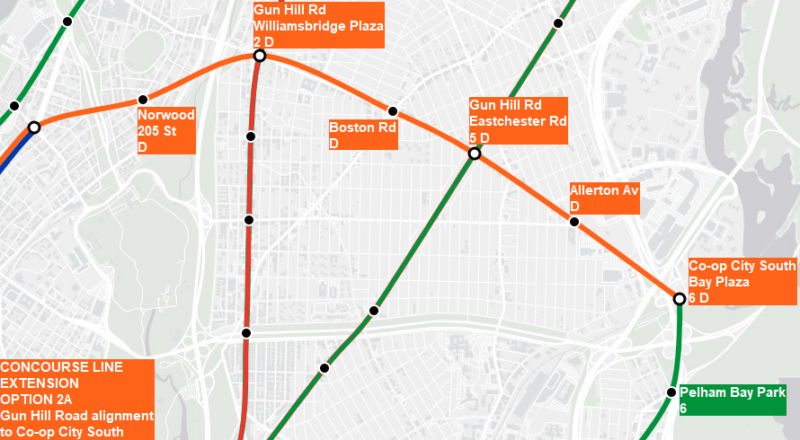
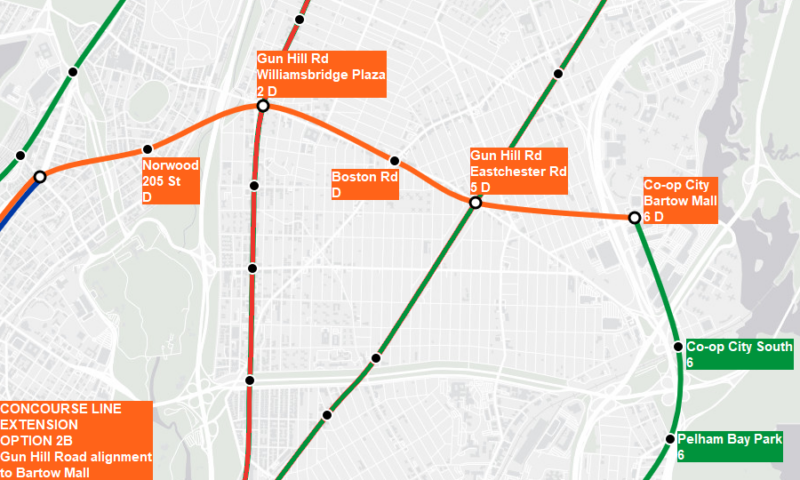
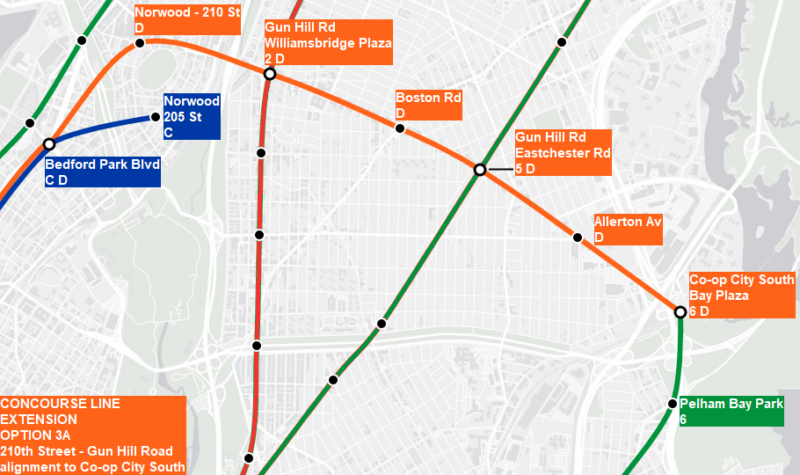
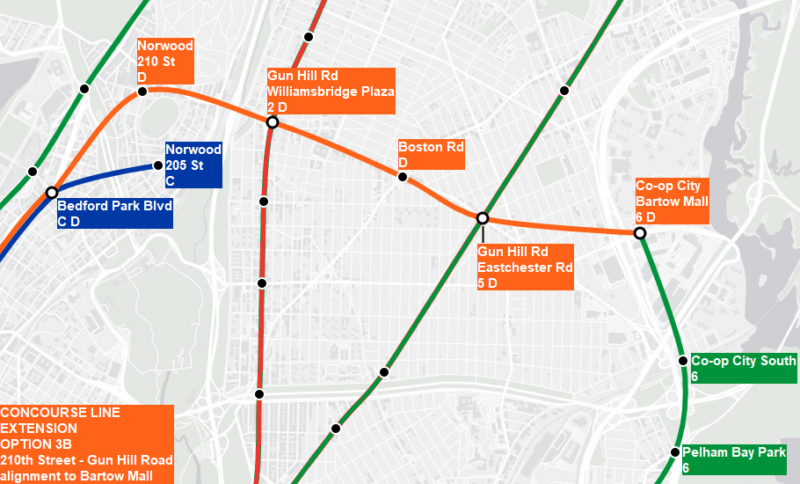
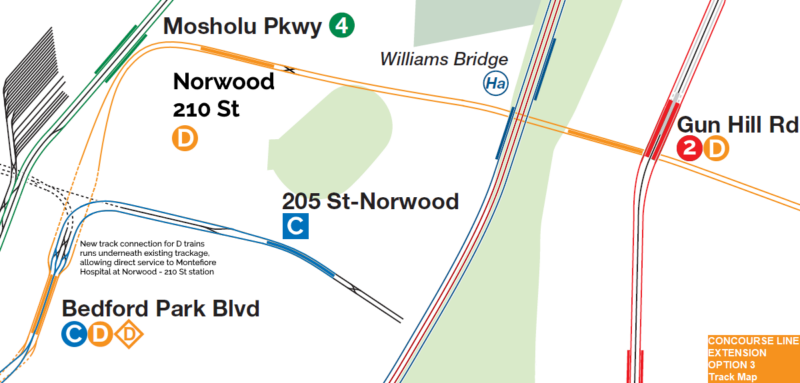
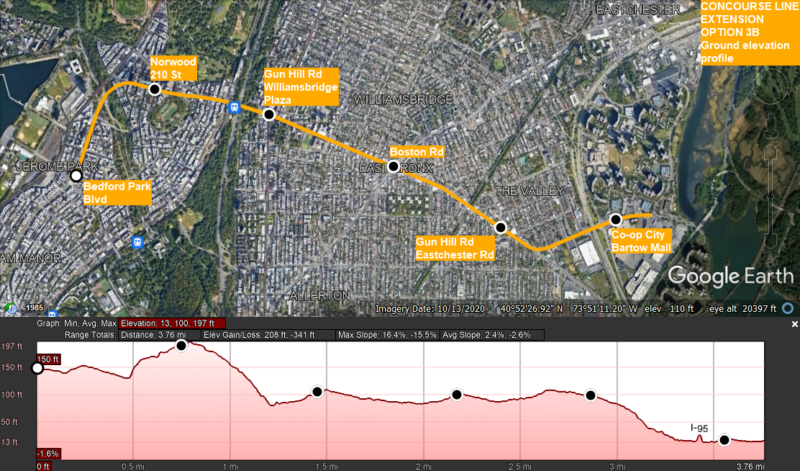
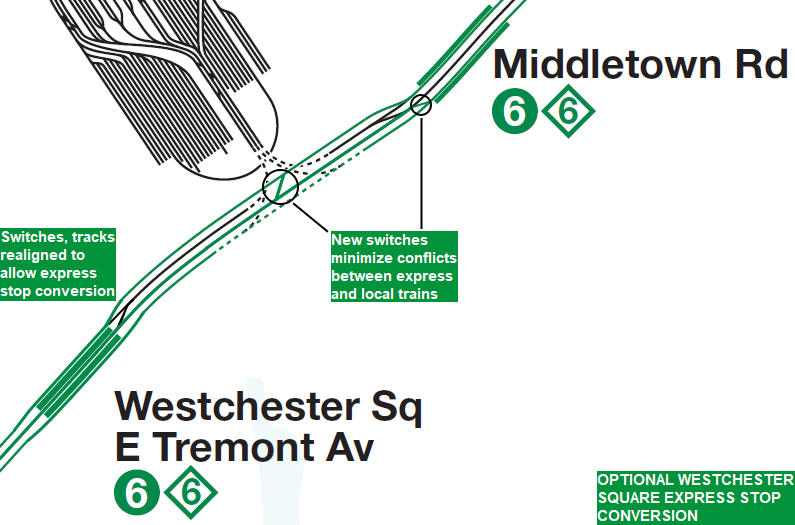
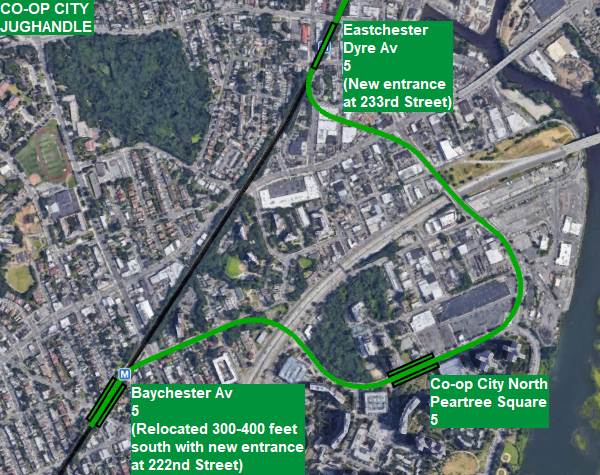
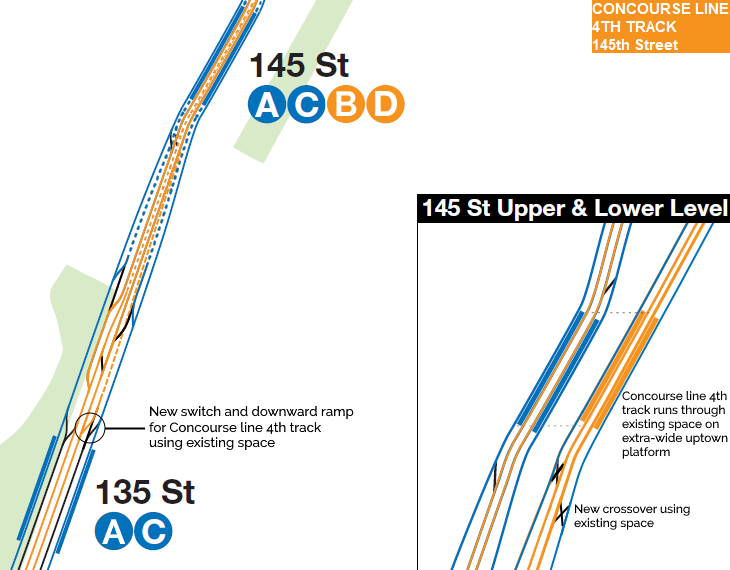
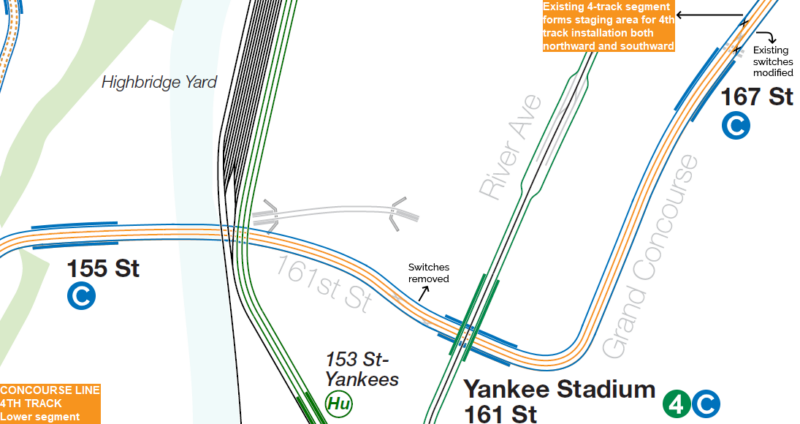
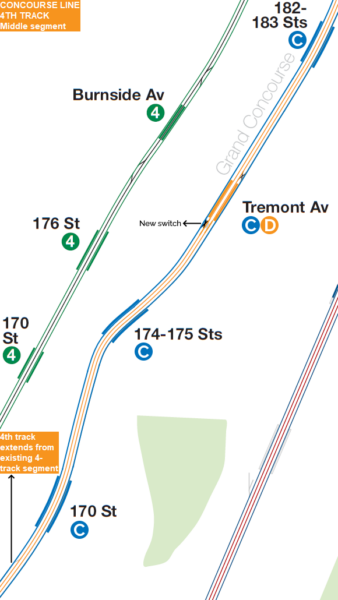
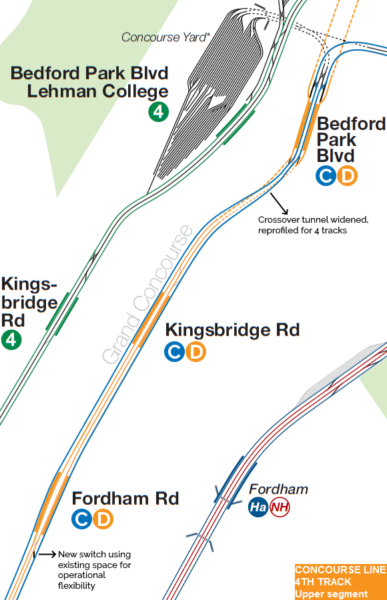
I’m so glad you included an extended #6 in your plans. This is a game changer for anyone living and traveling in the Bronx. Just the fact you could now travel through the Bronx just makes life simpler, living, shopping and working in the Bronx.
The tail tracks past the Norwood-205th St station are pointing towards Burke Ave, not Gun Hill Rd on the White Plains Line. If there are no plans for directional express on the WPL, it shouldn’t matter which station the Concourse extension connects to, and therefore it would be a much straighter ROW if it were to continue under Burke Ave and Gun Hill Rd, rather than Gun Hill Rd all the way.
While it’s true that the Burke Avenue alignment is the straighter shot (and indeed, the original plan for the Concourse extension), such an extension would disturb Bronx Park and the Bronx River – both of which are protected IINM. Since the tracks end at Webster, a Gun Hill alignment would begin somewhat west of there. I haven’t considered the WPL express north of East 180th, so if it’s possible to build a Burke Avenue subway without impacting the Bronx Park and River, then I’m not opposed (though it’d likely have to be underground).
Hi Leo:
I wanted to swing back to this comment, because a recent post update addresses this. The “straight-shot” alignment via Burke Avenue is no longer feasible since the Bronx Park Preserve is Forever Wild.